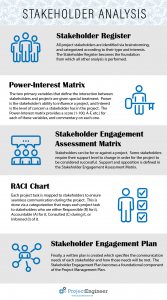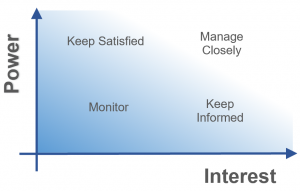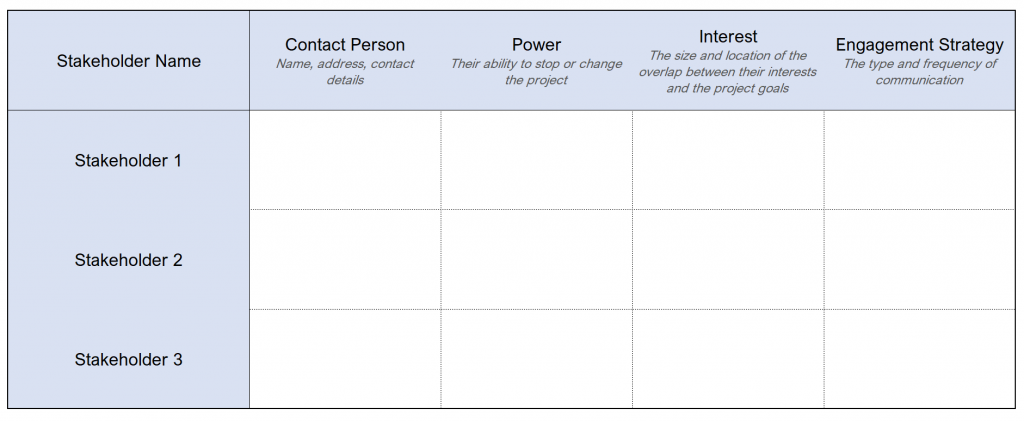
Stakeholders are to a project like players are to a team. Having the best players is one of the easiest ways to win the game, although strategy and tactics led by the coach (project manager) can go a long ways.
Thus, successful projects know who their stakeholders are and what motivates them. That’s where stakeholder analysis comes in.
What is a Stakeholder Analysis?
A stakeholder analysis is a tool used to plan stakeholder engagement efforts. Stakeholders can include project sponsors, team members, customers, executives, regulators, or even external communities. The analysis evaluates their influence, interest, and potential impact, enabling project managers to prioritize engagement efforts and tailor communication strategies.
Why You Need a Stakeholder Analysis
A good stakeholder analysis ensures that all of a project’s stakeholders are being adequately consulted in the most effective ways and thus remain supportive of the project (or increase their support level). By understanding stakeholders’ perspectives, you can anticipate challenges, secure buy-in, and foster collaboration.
How to Use a Stakeholder Analysis
 A stakeholder analysis is consulted in the development of stakeholder communication plans and should be reviewed on regular intervals to ensure its continued relevance in light of changing stakeholder priorities and business goals.
A stakeholder analysis is consulted in the development of stakeholder communication plans and should be reviewed on regular intervals to ensure its continued relevance in light of changing stakeholder priorities and business goals.
What Does a Stakeholder Analysis Look Like?
A Stakeholder Analysis consists of a document that identifies each project stakeholder and describes their underlying motivations, as well as several charts that categorize and prioritize the stakeholders in standardized ways. These are used to develop stakeholder engagement plans.
Why Stakeholder Analysis Matters
Before diving into the how-to, it’s worth understanding why stakeholder analysis is so valuable. Projects often fail not because of technical issues but due to misaligned expectations or lack of stakeholder support. A thorough stakeholder analysis:
- Clarifies priorities: Identifies who holds the most influence and whose needs are critical.
- Reduces risks: Anticipates potential opposition or conflicts early in the project.
- Enhances communication: Tailors engagement strategies to stakeholders’ preferences.
- Drives success: Aligns project goals with stakeholder expectations, increasing the likelihood of approval and adoption.
With these benefits in mind, let’s explore the step-by-step process for conducting a stakeholder analysis.
Step-by-Step Guide to Performing a Stakeholder Analysis
Stakeholder analysis contains the following steps:
- Identify Stakeholders
The first step is to create a comprehensive list of all individuals, groups, or entities affected by or capable of influencing the project. - Gather Information About Stakeholders
The stakeholder’s role, such as Coordinating Party, Funding Agency, etc. provides a good general idea as to how they should be treated. Also, the stakeholder’s main concerns are documented. Any other subsidiary concerns and underlying motivations are brainstormed and itemized - Quantify Influence and Interest
Power is the stakeholder’s ability to influence a project. Interest is the stakeholder’s level of concern about the project. These ranges from total control, for example a government regulatory agency, to a minor stakeholder that wants to be kept informed. - Analyze Stakeholder Relationships
Understanding how stakeholders interact with each other is crucial for managing dynamics and avoiding conflicts. - Identify Desirable Change to Stakeholder Positions
Some stakeholders need to change their status in order to produce project success, for example a local landowner that is opposed to a development. - Map stakeholder connections to project tasks
Each project task is inspected and each stakeholder designated on the RACI (pronounced “racy”) scale:- Responsible for it
- Accountable for it
- Consulted about it
- Informed of it
- Create a stakeholder engagement plan
This plan specifies how the stakeholder will be communicated with, how, and how often.
The Stakeholder Engagement Plan serves as a master guiding document that ensures the stakeholder is adequately consulted and is used in project control. That means that on regular intervals the project manager reports on how the plan was implemented, what the results were, and if changes to the plan are necessary.
Identify Stakeholders
Before stakeholders can be analyzed, they must be identified. It is remarkably easy to overlook a small stakeholder who’s ability to derail the project becomes disproportionately large when they are not adequately consulted. Don’t give the ball away early in the game else you will have a mountain to climb.
A stakeholder register is developed and updated regularly with stakeholder changes. Here is a quick checklist to help identify project stakeholders:
- Executives are stakeholders from the parent level organization, including the project sponsor.
- Customers pay for the product or service (the deliverables) the project produces.
- The Project Team produces those products and services.
- Technical / Department managers provide expert advice and resources to the project.
- Lenders, creditors, and investors provide financing to the project.
- Suppliers provide external products and services.
- Governments produce regulations the project must abide by, and issue permits and approvals.
- Local committees and boards approve the project’s deliverables.
- Unions negotiate for better working conditions and pay for the project team.
Gather Information About Stakeholders
Once you’ve identified stakeholders, collect details to understand their roles, interests, and expectations. Key information to gather includes:
- Roles and responsibilities: What is their position in the organization or project? Are they decision-makers, influencers, or end-users?
- Interests: What are their goals or concerns related to the project? For instance, a CFO might prioritize cost savings, while end-users focus on usability.
- Influence and power: How much authority do they have to affect project decisions or outcomes?
- Expectations: What do they hope to gain from the project? Are there specific deliverables or outcomes they prioritize?
- Attitude: Are they supportive, neutral, or resistant to the project?
You can gather this information through interviews, surveys, or workshops. For example, a brief questionnaire asking stakeholders about their priorities and concerns can provide valuable insights.
Tip: Document this information in your stakeholder register, adding columns for interests, influence, and attitude to keep everything organized.
Quantify Interest and Influence
If you don’t know where the goal line is, you don’t stand a very good chance of winning the game.
There are two primary variables which define stakeholders and how they influence the project.
- Power is the ability of the stakeholder to change or stop the project.
- Interest is the amount of involvement the stakeholder has in the project. It is the size of the overlap between the stakeholder’s and the project’s needs.
For this reason, the most common stakeholder analysis technique is a power-interest matrix. This chart might seem very simple on the surface, but provides a volume of information about a stakeholder and how to manage them.
 It contains the stakeholder’s interest level on the x-axis, and the power level on the y-axis.
It contains the stakeholder’s interest level on the x-axis, and the power level on the y-axis.
The four quadrants where each stakeholder lies each have different management characteristics.
- Those with low power and low interest must by monitored to ensure that they are not able to stop or change the project.
- Those with high power, low interest must be kept satisfied to ensure that a minor stakeholder doesn’t derail the project.
- Those with low power, high interest must be kept informed to ensure they are on side.
- Those with high power, high interest must be actively managed as they have a major influence on the project.
For example, a government regulatory approval agency might have very high power, but very low interest in the project. They must be kept satisfied or they might withhold permits. Likewise, an environmental protester might have very low power, but high interest. They must be kept informed so that they do not mobilize excessive resistance.
The power-interest matrix contains simply a dot that shows where the stakeholder sits on the chart. A larger stakeholder analysis matrix can expand on the definitions of where that power comes from, how they exercise it, and what their interest in the project is.
 The Stakeholder Analysis Matrix template gives you a few words to describe the power, interest, and engagement strategy, which is a little bit more information than the power-interest matrix. But many projects require more than a few words. In this case, these columns then expand into a written document called a stakeholder engagement plan.
The Stakeholder Analysis Matrix template gives you a few words to describe the power, interest, and engagement strategy, which is a little bit more information than the power-interest matrix. But many projects require more than a few words. In this case, these columns then expand into a written document called a stakeholder engagement plan.
The stakeholder engagement plan can also contain a written analysis of each stakeholder which includes support vs. resistance and underlying motivational factors. I will address both of those next.
Analyze Stakeholder Relationships
Understanding how stakeholders interact with each other is crucial for managing dynamics and avoiding conflicts. Consider:
- Alliances: Are there groups of stakeholders with aligned interests who can collaborate?
- Conflicts: Are there stakeholders with opposing goals? For example, a marketing team might push for a quick launch, while the quality assurance team prioritizes thorough testing.
- Influence networks: Who influences whom? A department head might sway team members’ opinions.
Mapping these relationships can be done through a Stakeholder Map, a diagram showing connections between stakeholders. This helps identify potential advocates or roadblocks.
Tip: Use stakeholder interviews or team discussions to uncover these dynamics, and update your stakeholder register with notes on relationships.
Identify Desirable Changes to Stakeholder Positions
On most projects the stakeholders play on different teams. They have different values and interests. These competing interests mandate that project managers not only understand stakeholder needs and objectives but also possess strong conflict resolution skills, negotiation skills, and communication skills.
Supportive stakeholders don’t occupy alot of the project manager’s time because they won’t get in the way. They also won’t occupy alot of my time in writing this article, because project managers who hoist the trophy are those who effectively manager stakeholders who are opposed to, not supportive of, the project.
There are five levels of support in which each stakeholder falls:
- Unaware
The stakeholder is unaware of the project and its potential consequences to them. - Resistant
The stakeholder is aware of the project but opposed to it. - Neutral
The stakeholder is neither supportive nor opposed to the project. - Supportive
The stakeholder is in favor of the project, and wants it to succeed. - Leading
The stakeholder is actively engaged in project success, and willing to lend assistance to the project management team.
The support levels of each stakeholder are tracked using a Stakeholder Engagement Assessment matrix. This grid shows where each stakeholder is in terms of project support, versus where the project management team would like them to be. It shows you where the ball is now, versus where the goal line is. The letter “C” is used to denote where the stakeholder is currently, and the letter “D” is used to denote where the desired location is.
 A common scenario is that a stakeholder who is located in the “Resistant” category must be moved in the “Neutral” or “Supportive” category. This scenario is difficult to accomplish and requires significant resources and effort of the project management team. Nonetheless, the stakeholder engagement assessment matrix clearly articulates the predicament the team finds itself in. You can’t say you weren’t told.
A common scenario is that a stakeholder who is located in the “Resistant” category must be moved in the “Neutral” or “Supportive” category. This scenario is difficult to accomplish and requires significant resources and effort of the project management team. Nonetheless, the stakeholder engagement assessment matrix clearly articulates the predicament the team finds itself in. You can’t say you weren’t told.
Some stakeholders in the “Resistant” category do not necessarily need to be moved, that is, the project might not need their blessing to proceed. But they will probably get even more unhappy and could attempt to use their influence to derail the project.
Map Stakeholder Connections to Project Tasks
A RACI chart is an effective tool for mapping stakeholder interests to project tasks, ensuring clarity in roles and alignment with stakeholder priorities.
By categorizing responsibilities as Responsible (task executor), Accountable (task owner), Consulted (provides input), or Informed (receives updates), the chart connects specific project tasks to stakeholders based on their interests and influence. For example, a stakeholder with a high interest in project quality, such as a quality assurance manager, might be marked as Consulted for testing tasks to provide expertise, while a project sponsor, focused on budget and timelines, would be Accountable for approving key deliverables. This mapping ensures tasks reflect stakeholder priorities, fosters collaboration, and minimizes miscommunication by clearly defining who does what, aligning project execution with stakeholder expectations.
Create Stakeholder Engagement Plan
With stakeholders categorized and relationships understood, create a tailored engagement plan to manage communication and involvement. For each stakeholder or group, define:
- Communication method: How will you engage them? Options include emails, meetings, reports, or presentations.
- Frequency: How often will you communicate? High-power, high-interest stakeholders might need weekly updates, while others suffice with monthly summaries.
- Key messages: What information do they need? For example, executives might want high-level progress reports, while team members need detailed task updates.
- Engagement goals: What do you aim to achieve? This could be securing buy-in, addressing concerns, or ensuring alignment.
For instance, for a high-power, high-interest stakeholder like a project sponsor, you might schedule bi-weekly one-on-one meetings to discuss milestones and risks. For low-power, high-interest stakeholders like end-users, you might host a monthly webinar to gather feedback.
Tip: Use a stakeholder engagement matrix to outline these details, ensuring consistency and clarity in your approach.
Stakeholder Driving Factors
The underlying driving factors that influence stakeholder actions are unique to each stakeholder. The stakeholder analysis must attempt to identify and interpret those underlying factors and address them as necessary.
- Financial interests
The stakeholder will make or lose money (or income) because of the project. - Moral and ethical values
The stakeholder does or does not believe that the project represents a ethical undertaking that should be sanctioned but society. - Rights
Legal rights, such as Occupational Health & Safety, affect the stakeholder’s opinion of the project. - Religious beliefs
The stakeholder’s religious beliefs result in an opinion about the project. - Political opinions
The political opinions of the stakeholders cause them to support or resist the project. - Business interests
The stakeholder will realize an increase or decrease in business revenue as a result of the project. - Knowledge
The level of knowledge a stakeholder has about a project is often a large factor in determining their support. - Demographics
The age and population characteristics affect the support for, or resistance against, the project. - Environmental stewardship
The stakeholder is supportive or opposed to the project because of its environmental footprint. - Value of ownership
The stakeholder will gain or lose value of something they own, like a property. - Communication preferences
Stakeholders have vastly differing communication preferences which affect their support for the project.
To make things even more difficult (you didn’t think it would be easy did you?), the project’s effect on these underlying factors are often not clear. For example, whether Mr. Smith’s house will increase in value due to the project is not known for sure.
Remember, those that exercise good sportsmanship will often have the favor returned, even if you don’t see the immediate payoff yet.
Best Practices for Effective Stakeholder Analysis
To maximize the impact of your stakeholder analysis, keep these best practices in mind:
- Start early: Conduct the analysis during the project’s initiation phase to set a strong foundation.
- Be inclusive: Engage a diverse range of stakeholders to capture varied perspectives.
- Stay objective: Assess influence and interest based on evidence, not assumptions.
- Communicate clearly: Ensure stakeholders understand the project’s goals and their role in it.
- Use tools: Leverage templates, grids, and software to streamline the process and maintain organization.
Common Pitfalls to Avoid
While stakeholder analysis is straightforward, mistakes can undermine its effectiveness. Watch out for:
- Overlooking stakeholders: Missing key players can lead to blind spots and resistance.
- Assuming static roles: Stakeholders’ influence or interest may shift, so stay flexible.
- Neglecting communication: Failing to engage stakeholders regularly can erode trust.
- Overcomplicating the process: Keep your analysis focused and actionable to avoid analysis paralysis.
The Project Management Body of Knowledge (PMBOK)
The Stakeholders Performance Domain is the first of the eight Project Performance Domains in the The PMBOK. Stakeholder Analysis is a method underneath this performance domain, which is described as follows:
- This technique involves systematically gathering and analyzing quantitative and qualitative information about stakeholders to determine whose interests should be taken into account throughout the project.
Conclusion
Performing a stakeholder analysis is a cornerstone of successful project management. By systematically identifying stakeholders, assessing their influence and interest, and crafting a tailored engagement plan, you can align expectations, mitigate risks, and drive project success. Whether you’re managing a small team project or a large-scale initiative, these steps—identifying stakeholders, gathering information, categorizing them, analyzing relationships, and maintaining an adaptive engagement plan—will empower you to navigate complex stakeholder dynamics with confidence.
Start your stakeholder analysis today, and watch how it transforms your project’s clarity, collaboration, and outcomes. By putting stakeholders at the heart of your strategy, you’re not just managing a project—you’re building a foundation for lasting success.












 business analyst says
business analyst says
April 22, 2019 at 1:15 amBeautiful piece, it was so helpful to me as I have been conducting pieces of training but leaving somewhere important bits and pieces that you have highlighted here. Your piece can see a trainer through a training program successfully. Thanks.
 Steeve says
Steeve says
May 6, 2019 at 9:56 amThanks alot for this excellent article.
I just want to know the difference between financial interests ans business interests as far as stakeholders are concerned.
 Edna says
Edna says
August 13, 2019 at 2:52 pmI would like to ask permission to use this Stakeholders Analysis model in my management planning.
 Bernie Roseke, P.Eng., PMP says
Bernie Roseke, P.Eng., PMP says
September 7, 2019 at 10:15 amYou have permission to use and redistribute this article